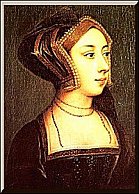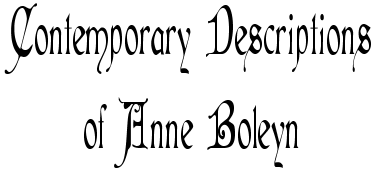 Contemporary descriptions of
Henry VIII's infamous second wife vary widely. Even her
admirers and supporters found it difficult to praise her physical
appearance. She was striking but not beautiful; her sister Mary was
considered the beauty of the Boleyn family. Contemporary descriptions of
Henry VIII's infamous second wife vary widely. Even her
admirers and supporters found it difficult to praise her physical
appearance. She was striking but not beautiful; her sister Mary was
considered the beauty of the Boleyn family. There were occasional comments from hostile sources
that Anne had the attributes of a witch - a large mole on her neck, possibly
an extra finger. The latter is probably true. When reading the following comments,
remember
that most observers at Henry's court were not friendly with Anne.
Naturally, their descriptions of her were colored by their dislike.
Also, contemporary views about her lifestyle were
influenced by one overriding fact: most people believed she was the sole
force behind the Henrician reformation. Katharine of Aragon was popular
and respected. Cast as the interloper, Anne was suitably despised. |
|
In the early 1530s, the Venetian ambassador
Savorgnano wrote:
Anne was 'a young woman of noble birth, though many say of bad character,
whose will is law to him, and he is expected to marry her should the divorce
take place, which it is supposed will not be effected, as the peers of
the realm.... and the people are opposed to it.'
The Abbot of Whitby describes the
political situation in 1530:
'The King's Grace is ruled by one common stewed whore, Anne Boleyn,
who makes all the spirituality to be beggared, and the temporality also.'
Henry VIII ordered Katharine of
Aragon to relinquish certain jewels (property of the crown) to Anne Boleyn;
Katharine replied:
'I will not give them up to a person who is the scandal of Christendom
and a disgrace to you.'
In 1532, a new Venetian ambassador described Anne
thusly:
'not one of the handsomest women in the world. She is of middling
stature, with a swarthy complexion, long neck, wide mouth, bosom not much
raised, and in fact has nothing but the King's great appetite, and her
eyes, which are black and beautiful - and take great effect on those who
served the Queen when she was on the throne. She lives like a queen,
and the King accompanies her to Mass - and everywhere.'
And the French ambassador contradicts Anne's
enemies; he reports that she is controlled by the king:
'....all that the Lady does is by the king's order.'
The Imperial ambassador, Eustace Chapuys, described circumstances in early 1533 to his master, Charles V:
'Your Majesty must root out the Lady and her adherents.... This accursed
Anne has her foot in the stirrup, and will do the Queen and the Princess
all the harm she can. She has boasted that she will make the Princess
her lady-in-waiting, or marry her to some varlet.'
Chapuys describes Anne's attendance
at Mass on 14 April 1533:
'It looks like a dream, and even those who take her part know not whether
to laugh or to cry.'
Henry and Anne's conversation at
her coronation procession was reported by Chapuys:
'How liked you the look of the City?' Henry asked.
Anne replied, 'Sir, I liked the City well enough - but I saw a great
many caps on heads, and heard but few tongues.'
Thomas Cranmer, Archbishop of Canterbury,
was Anne's friend and champion. When news reached him of her arrest,
he bravely wrote to Henry VIII protesting - only to think better of offending
Henry. Cranmer added a suitably apologetic postscript to the letter.
Here are excerpts in which he describes Anne:
'If it be true that is openly reported of the Queen's Grace... I am
in such perplexity that my mind is clean amazed; for I never had better
opinion in woman than I had in her; which maketh me to think that she should
not be culpable... Next to Your Grace, I was most bound to her of
all creatures living... I wish and pray for her that she may declare herself
inculpable and innocent... I loved her not a little for the love which
I judged her to bear towards God and His Gospel.'
to the Anne
Boleyn website
to Primary Sources |

 Contemporary descriptions of
Henry VIII's infamous second wife vary widely. Even her
admirers and supporters found it difficult to praise her physical
appearance. She was striking but not beautiful; her sister Mary was
considered the beauty of the Boleyn family.
Contemporary descriptions of
Henry VIII's infamous second wife vary widely. Even her
admirers and supporters found it difficult to praise her physical
appearance. She was striking but not beautiful; her sister Mary was
considered the beauty of the Boleyn family.